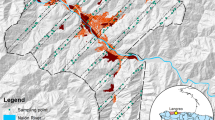Abstract
Introduction
The pollution of soil and environment as a result of human activity is a major problem. Nowadays, the determination of local contaminations is of interest for environmental remediation. These hotspots can have various toxic effects on plants, animals, humans, and the whole ecological system. However, economical and juridical consequences are also possible, e.g., high costs for remediation measures.
Materials and methods
In this study three sampling strategies (simple random sampling, stratified sampling, and systematic sampling) were applied on randomly distributed hotspot contaminations to prove their efficiency in term of finding hotspots. The results were used for the validation of a computerized simulation.
Results and conclusion
This application can simulate the contamination on a field, the sampling pattern, and a virtual sampling. A constant hit rate showed that none of the sampling patterns could reach better results than others. Furthermore, the uncertainty associated with the results is described by confidence intervals. It is to be considered that the uncertainty during sampling is enormous and will decrease slightly, even the number of samples applied was increased to an unreasonable amount. It is hardly possible to identify the exact number of randomly distributed hotspot contaminations by statistical sampling. But a range of possible results could be calculated. Depending on various parameters such as shape and size of the area, number of hotspots, and sample quantity, optimal sampling strategies could be derived. Furthermore, an estimation of bias arising from sampling methodology is possible. The developed computerized simulation is an innovative tool for optimizing sampling strategies in terrestrial compartments for hotspot distributions.





Similar content being viewed by others
References
Barth DS, Mason BJ, Starks TH, Brown KW (1989) Soil Sampling Quality Assurance User’s Guide, 2nd edn. United States Environmental Protection Agency EPA/600/8-69/046, Las Vegas
BBodSchG (1998) Bundes-Bodenschutzgesetz. BGBl, Köln (in German)
BBodSchV (1999) Bundes-Bodenschutz- und Altlastenverordnung. BGBl, Köln (in German)
Clopper CJ, Pearson ES (1934) The use of confidence or fiducial limits illustrated in the case of the binomial. Biometrika 26(4):404–413. doi:10.1093/biomet/26.4.404
CLR4 (1994) Sampling strategies for contaminated land. Contaminated land research report (1). The Centre for Research into the Built Environment, Nottingham Trent University
DIN 19746:2005–06 (2005) Soil quality—determination of mineral nitrogen (nitrat and ammonium) in soil profiles (Nmin laboratory method). Beuth, Berlin
Doerffel K (1990) Statistik in der analytischen Chemie, 5. Auflage. Deutscher Verlag für Grundstoffindustrie GmbH, Leipzig (in German)
Gržetić I, Ghariani RHA (2008) Potential health risk assessment for soil heavy metal contamination in the central zone of Belgrade (Serbia). Journal of the Serbian Chemical Society 73(8–9):923–934, Belgrade
Harte D (2002) Non asymptotic binomial confidence intervals. Statistics Research Associates, Wellington
Hellawell EE, Kemp AC, Nancarrow DJ (2001) A GIS raster technique to optimise contaminated soil removal. Eng Geol 60:107–116
ISO 10381–1:2002 (2002) Soil quality—sampling—part 1: guidance on the design of sampling programmes. Beuth, Berlin
ISO 10381–5:2007–02 (2007) Soil quality—sampling—part 5: guidance on the procedure for the investigation of urban and industrial sites with regard to soil contamination. Beuth, Berlin
LfULG (1999) Materialien zur Altlastenbehandlung, Vor-Ort-Analytik. Nr. 1/99. Sächsisches Landesamt für Umwelt, Landwirtschaft und Geologie (in German)
Li XD, Lee S, Wong S, Shi W, Thornton I (2004) The study of metal contamination in urban soils of Hong Kong using a GIS-based approach. Environ Pollut 129:113–124
Lombi E, Wenzel WW, Adriano DC (1998) Soil contamination, risk reduction and remediation. In: Birch P (ed) Land contamination and reclamation. EPP Publications, Surrey, pp 183–197
Merton RK (1948) The self-fulfilling prophecy. Antioch Rev 8:193–210
Squire S, Ramsey MH, Gardner MJ (2000) Collaborative trial in sampling for the spatial delineation of contamination and the estimation of uncertainty. Analyst 125:139–145
Tse KKC, Lo S, Wang JWH (2001) Pilot study of in-situ thermal treatment for the remediation of pentachlorophenol-contaminated aquifers. Environ Sci Technol 35:4910–4915
Acknowledgments
The authors thank the German Federal Ministry of Economics and Technology (BMWi) for the financial support of the project and the Agricultural Institute for Investigation and Research of Thuringia (TLL) for providing the test field and supporting the analysis.
Author information
Authors and Affiliations
Corresponding author
Additional information
Responsible editor: Zhihong Xu
Rights and permissions
About this article
Cite this article
Hildebrandt, T., Pick, D. & Einax, J.W. Improvement of sampling strategies for randomly distributed hotspots in soil applying a computerized simulation considering the concept of uncertainty. Environ Sci Pollut Res 19, 372–378 (2012). https://doi.org/10.1007/s11356-011-0568-3
Received:
Accepted:
Published:
Issue Date:
DOI: https://doi.org/10.1007/s11356-011-0568-3




